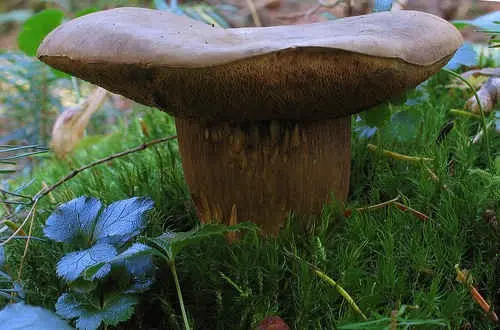Porfirosporous porphyry (Porphyrellus porphyrosporus)
- Division: Basidiomycota (Basidiomycetes)
- Subdivision: Agaricomycotina (Agaricomycetes)
- Class: Agaricomycetes (Agaricomycetes)
- Subclass: Agaricomycetidae (Agaricomycetes)
- Order: Boletales (Boletales)
- Family: Boletaceae (Boletaceae)
- Genus: Porphyrellus
- Type: Porphyrellus porphyrosporus (porphyrosporous porphyry)
- Purpurospore boletus
- Hericium porphyry
- Chocolate man
- red spore porphyrellus

Hat: the mushroom cap first has a hemispherical shape, then becomes convex, thick and fleshy with a smooth, shiny and velvety skin. The surface of the cap is grayish in color with a silky sheen, which can change during the ripening of the fungus, to dark brown.
Leg: smooth, cylindrical leg with thin longitudinal grooves. The stem of the mushroom has the same grayish color as its cap.
Pores: small, round shape.
Tubes: long, when pressed become bluish-green.
Pulp: fibrous, loose, sour taste. The smell is also sour and unpleasant. The flesh of the fungus can be purple, brownish or yellow-straw.
The porphyrosporous porphyry is found in the southern part of the Alps, and this species is also quite common in the Central part of Europe. It grows in coniferous and deciduous forests, as a rule, prefers mountainous terrain. The fruiting period is from late summer to late autumn.
Due to the unpleasant odor, porphyrosporous porphyry belongs to conditionally edible mushrooms. The smell remains even after boiling it. Suitable for marinated use.
It resembles either a bolt or a flywheel. Therefore, it is sometimes referred to one, then to another genus, or even referred to a special genus – a pseudo-bolt.









